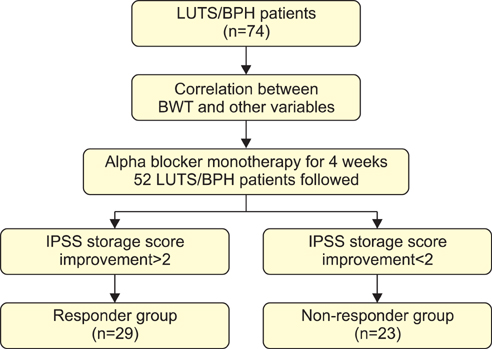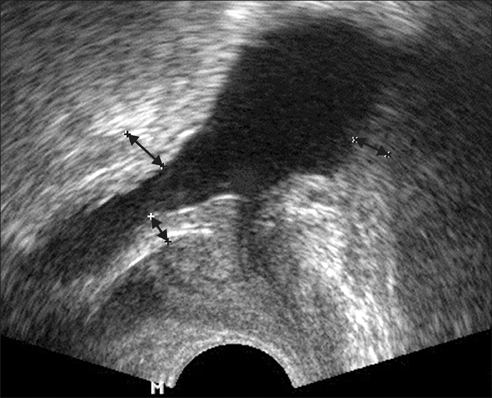Korean J Urol.
2012 Jul;53(7):487-491. 10.4111/kju.2012.53.7.487.
Bladder Wall Thickness is Associated with Responsiveness of Storage Symptoms to Alpha-Blockers in Men with Lower Urinary Tract Symptoms
- Affiliations
-
- 1Department of Urology, Hanyang University College of Medicine, Seoul, Korea. ytkimuro@hanyang.ac.kr
- KMID: 1988761
- DOI: http://doi.org/10.4111/kju.2012.53.7.487
Abstract
- PURPOSE
Bladder wall thickness (BWT) is reported to be related to detrusor overactivity and bladder outlet obstruction. We investigated the relationship between BWT and the responsiveness of storage symptoms to alpha-blockers in men with lower urinary tract symptoms (LUTS).
MATERIALS AND METHODS
A total of 74 patients with LUTS were enrolled. International Prostate Symptom Score, uroflowmetry with post-void residual urine volume, and transrectal ultrasonography (TRUS) were investigated. BWT was measured by performing TRUS at the midsagittal plane view, and the average value of BWT at the anterior, dome, and trigone areas was used. After 4 weeks of alpha-blocker medication, patients were reevaluated and divided into two groups. The responder group consisted of patients who reported improvement in the storage symptom subscore of 2 points or more; the non-responder group consisted of patients who reported improvement of less than 2 points. Clinical parameters including BWT were compared between the two groups.
RESULTS
A total of 52 patients were followed. BWT was positively correlated with intravesical prostate protrusion (IPP) (9.26+/-4.99, standardized beta=0.393, p=0.002) and storage symptom subscore (0.35+/-0.43, standardized beta=0.458, p=0.002). Compared with that in the responder group, BWT was thicker in the non-responder group, and improvement in the storage symptom score was correlated with BWT (0.58+/-0.09 cm vs. 0.65+/-0.11 cm, p=0.018) and prostate volume (27.08+/-16.26 ml vs. 36.44+/-10.1 ml, p=0.018).
CONCLUSIONS
BWT was correlated with IPP, the storage symptom subscore, and the responsiveness of storage symptoms to alpha-blockers in LUTS/benign prostatic hyperplasia (BPH) patients. As BWT increased, the responsiveness of storage symptoms to alpha-blocker decreased in LUTS/BPH patients.
MeSH Terms
Figure
Reference
-
1. Manieri C, Carter SS, Romano G, Trucchi A, Valenti M, Tubaro A. The diagnosis of bladder outlet obstruction in men by ultrasound measurement of bladder wall thickness. J Urol. 1998. 159:761–765.2. Elbadawi A, Yalla SV, Resnick NM. Structural basis of geriatric voiding dysfunction. IV. Bladder outlet obstruction. J Urol. 1993. 150(5 Pt 2):1681–1695.3. Farag FF, Heesakkers JP. Non-invasive techniques in the diagnosis of bladder storage disorders. Neurourol Urodyn. 2011. 30:1422–1428.4. Bright E, Oelke M, Tubaro A, Abrams P. Ultrasound estimated bladder weight and measurement of bladder wall thickness--useful noninvasive methods for assessing the lower urinary tract? J Urol. 2010. 184:1847–1854.5. Hakenberg OW, Linne C, Manseck A, Wirth MP. Bladder wall thickness in normal adults and men with mild lower urinary tract symptoms and benign prostatic enlargement. Neurourol Urodyn. 2000. 19:585–593.6. McVary KT, Roehrborn CG, Avins AL, Barry MJ, Bruskewitz RC, Donnell RF, et al. Update on AUA guideline on the management of benign prostatic hyperplasia. J Urol. 2011. 185:1793–1803.7. Abrams P, Kaplan S, De Koning Gans HJ, Millard R. Safety and tolerability of tolterodine for the treatment of overactive bladder in men with bladder outlet obstruction. J Urol. 2006. 175(3 Pt 1):999–1004.8. Lee JY, Kim HW, Lee SJ, Koh JS, Suh HJ, Chancellor MB. Comparison of doxazosin with or without tolterodine in men with symptomatic bladder outlet obstruction and an overactive bladder. BJU Int. 2004. 94:817–820.9. Kaplan SA, Walmsley K, Te AE. Tolterodine extended release attenuates lower urinary tract symptoms in men with benign prostatic hyperplasia. J Urol. 2005. 174:2273–2275.10. Klingler HC, Madersbacher S, Djavan B, Schatzl G, Marberger M, Schmidbauer CP. Morbidity of the evaluation of the lower urinary tract with transurethral multichannel pressure-flow studies. J Urol. 1998. 159:191–194.11. Oelke M, Hofner K, Wiese B, Grunewald V, Jonas U. Increase in detrusor wall thickness indicates bladder outlet obstruction (BOO) in men. World J Urol. 2002. 19:443–452.12. Kessler TM, Gerber R, Burkhard FC, Studer UE, Danuser H. Ultrasound assessment of detrusor thickness in men-can it predict bladder outlet obstruction and replace pressure flow study? J Urol. 2006. 175:2170–2173.13. Oelke M, Hofner K, Jonas U, de la Rosette JJ, Ubbink DT, Wijkstra H. Diagnostic accuracy of noninvasive tests to evaluate bladder outlet obstruction in men: detrusor wall thickness, uroflowmetry, postvoid residual urine, and prostate volume. Eur Urol. 2007. 52:827–834.14. Kojima M, Inui E, Ochiai A, Naya Y, Ukimura O, Watanabe H. Noninvasive quantitative estimation of infravesical obstruction using ultrasonic measurement of bladder weight. J Urol. 1997. 157:476–479.15. Levin RM, Haugaard N, O'Connor L, Buttyan R, Das A, Dixon JS, et al. Obstructive response of human bladder to BPH vs. rabbit bladder response to partial outlet obstruction: a direct comparison. Neurourol Urodyn. 2000. 19:609–629.16. Mattiasson A, Uvelius B. Changes in contractile properties in hypertrophic rat urinary bladder. J Urol. 1982. 128:1340–1342.17. Kim SO, Song SH, Ahn K, Kwon D, Park K, Ryu SB. Changes in aquaporin 1 expression in rat urinary bladder after partial bladder outlet obstruction: preliminary report. Korean J Urol. 2010. 51:281–286.18. Ghoniem GM, Regnier CH, Biancani P, Johnson L, Susset JG. Effect of vesical outlet obstruction on detrusor contractility and passive properties in rabbits. J Urol. 1986. 135:1284–1289.19. Khullar V, Salvatore S, Cardozo L, Bourne TH, Abbott D, Kelleher C. A novel technique for measuring bladder wall thickness in women using transvaginal ultrasound. Ultrasound Obstet Gynecol. 1994. 4:220–223.20. Lekskulchai O, Dietz HP. Detrusor wall thickness as a test for detrusor overactivity in women. Ultrasound Obstet Gynecol. 2008. 32:535–539.21. Khullar V, Cardozo LD, Salvatore S, Hill S. Ultrasound: a noninvasive screening test for detrusor instability. Br J Obstet Gynaecol. 1996. 103:904–908.22. Serati M, Salvatore S, Cattoni E, Soligo M, Cromi A, Ghezzi F. Ultrasound measurement of bladder wall thickness in different forms of detrusor overactivity. Int Urogynecol J. 2010. 21:1405–1411.23. Jequier S, Rousseau O. Sonographic measurements of the normal bladder wall in children. AJR Am J Roentgenol. 1987. 149:563–566.24. Kojima M, Inui E, Ochiai A, Naya Y, Ukimura O, Watanabe H. Ultrasonic estimation of bladder weight as a measure of bladder hypertrophy in men with infravesical obstruction: a preliminary report. Urology. 1996. 47:942–947.25. Lee LS, Sim HG, Lim KB, Wang D, Foo KT. Intravesical prostatic protrusion predicts clinical progression of benign prostatic enlargement in patients receiving medical treatment. Int J Urol. 2010. 17:69–74.26. Choi SY, Kim TH, Myung SC, Moon YT, Kim KD, Kim YS, et al. Impact of changing trends in medical therapy on surgery for benign prostatic hyperplasia over two decades. Korean J Urol. 2012. 53:23–28.27. Greco KA, McVary KT. The role of combination medical therapy in benign prostatic hyperplasia. Int J Impot Res. 2008. 20 Suppl 3. S33–S43.
- Full Text Links
- Actions
-
Cited
- CITED
-
- Close
- Share
- Similar articles
-
- Clinical Outcome in Male Patients With Detrusor Overactivity With Impaired Contractility
- Changes in Bladder Wall Thickness and Detrusor Wall Thickness After Surgical Treatment of Benign Prostatic Enlargement in Patients With Lower Urinary Tract Symptoms: A Preliminary Report
- Shape-up LUTS/BPH Guideline in Korea: Medical Treatment
- Benign Prostatic Hyperplasia and Alpha Adrenoceptor Blockers
- Effect of 5-alpha Reductase Inhibitor on Storage Symptoms in Patients with Benign Prostatic Hyperplasia



